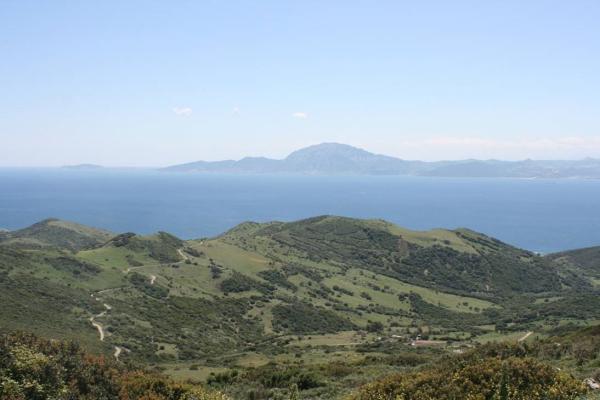
Biodiversity challenge: The IBRM transboundary setting contains several remarkable protected sites, high biodiversity richness and an important cultural heritage. However, pressures from human activities in the area are threatening these distinct values. Our aim is to understand the social and ecological system of the Reserve to design a multifunctional Green and Blue Infrastructure network - with conservation, exploitation and restoration objectives - and implement Ecosystem-Based Management measures with a comprehensive focus on freshwater, coastal and marine realms.
Context: The study area encompasses the IBRM in Andalusia (Spain) – Morocco and its area of influence. The reserve spans over two continents, Europe and Africa, and the marine area of the Strait of Gibraltar, and includes river basins, coastal, and marine areas (UNESCO-MAB 2011). Economic activities in both the northern and southern sections of the case study area are based on agriculture, livestock, fisheries, and tourism, all of which are highly dependent on terrestrial and aquatic resources. The aquatic ecosystems provide a vital range of provisioning goods, and cultural, regulation and maintenance services for sustaining human well-being.
What was done? In collaboration with regional and local governments of Andalusia (Spain) and Kingdom of Morocco, we applied the AQUACROSS Assessment Framework to develop and design a multi-purpose Green and Blue Infrastructure. This included:
- Analysing regional activities, pressures, ecosystem condition, biodiversity, and key aquatic ecosystem services;
- Identifying stakeholder objectives: synergies, conflicts, and opportunities for improvement;
- Green and Blue Infrastructure design based on spatial conservation prioritisation and modelling of biodiversity features and ecosystem services;
- Identifying the best spatial allocation for an ecosystem-based management plan for the restoration of degraded ecosystems;
- Co-creation with local stakeholders: two rounds of workshops held in Tarifa (Spain, northern section) and Tangier (Morocco, southern section).
Results: Our study identified the key areas that allow conserving biodiversity, maintaining ecosystem services capacity, and restoring degraded ecosystems, while minimising costs. The results suggest that implementing ecosystem-based management restoration measures when designing Green and Blue Infrastructure may result in greater coverage, while improving connectivity across its core and conservation zones.
Lessons learned for managing biodiversity: Green and Blue Infrastructure combines in one single solution an ecosystem-based management outcome that balances conservation, restoration and exploitation objectives. The Green and Blue Infrastructure multi-zoning approach offers co-benefits in terms of ecosystem and biodiversity conservation as well as human well-being, while minimising the potential conflicts between conservation and exploitation goals.
Applicability: The CS2 framework may be also useful in guiding Green and Blue Infrastructure investment at regional level. It also supports its integration in different policies at EU level and international/global level, among them, the Biodiversity Strategies, National Marine Strategies, Coastal Management Plans, and National Plans for Watershed Management in both Spain and Morocco.
The main results of the AQUACROSS Case Study 2, and its Area of Influence – are now available via a dedicated website that follows a storytelling approach. The purpose of the application is to use the power and the flexibility of storytelling to give a direct message and transmit knowledge acquired through the case study. The website compiling the results of the AQUACROSS Case Study 2 is available in English, Spanish, French and Arabic.
Lead partner Organisation: The Intergovernmental Oceanographic Commission of the United Nations Educational, Scientific and Cultural Organization (IOC-UNESCO) is leading the research in the case study.
Cooperating partner: The Environmental Information Network of Andalusia (Red de Información Ambiental de Andalucía, REDIAM) (REDIAM) is the cooperating organisation for AQUACROSS Case Study 2: Analyses of transboundary water ecosystems and blue/green infrastructure in the Intercontinental Biosphere Reserve of the Mediterranean, Andalusia (Spain) - Morocco. REDIAM, a department of the Regional Ministry of Environment and Spatial Planning of Andalusia, Spain, collects, coordinates, and disseminates all environmental data in Andalusia, Spain. It is responsible for ensuring that all data is collected in an appropriate and standardised manner to allow for it to be integrated into planning in Andalusia and also shared with the relevant national and international authorities. REDIAM and this case study are represented on the SPBTT by Mercedes Garcia-Padilla.
The State Secretary of Environment at the Ministry of Energy, Mines and Sustainable Development of the Government of the Kingdom of Morocco is a cooperating organisation for AQUACROSS with the mandate of monitoring, elaboration and execution of the governmental policy in the domain of environment and sustainable development.
With thanks to: The Government of Andalusia (Spain) and the Government of the Kingdom of Morocco

